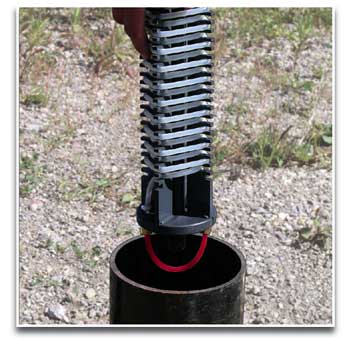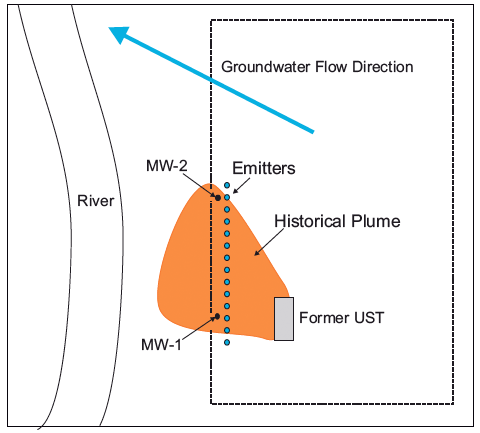Oxygen diffusion allows for quick remediation at a former fuel dispensing site
By Tricia Lane and Rick McGregor
Download![]() PDF (420Kb)*
PDF (420Kb)*
Historical releases of petroleum hydrocarbons at fuel dispensing facilities have resulted in impacts to groundwater and soil. These impacts may represent a risk to human health, the ecology, or present a liability to the facility owner.
Remedial approaches to these sites range from natural attenuation, to pump and treat, to excavation of all impacted materials. Limitations of these approaches include prolonged remedial time-frames and/or excessive costs.
At a former fuel dispensing site in southern Ontario, historical petroleum hydrocarbon impacts were preventing the site from being redeveloped, as well as representing a potential liability to the current site owner. During facility decommissioning activities in the mid-1990s, contamination in the shallow groundwater and soil were noted. Limited excavation was completed to remove readily accessible impacted soil. These initial excavation efforts failed to completely remediate the groundwater on the site, which was migrating towards a sensitive receptor down gradient.
In 2007, Vertex Environmental Inc., who specialize in the in situ remediation of contaminated groundwater, were contracted to assess and ultimately clean up the site. A review of remedial options for the vacant site was completed and recommended the installation of an enhanced bioremediation system involving the introduction of oxygen into the subsurface. However, concerns due to nearby residences limited the methods available for the introduction of oxygen to passive/ semi-passive techniques that would not produce petroleum hydrocarbon vapour.
Based on a technical and financial review, the recommended remedial approach involved the installation of Waterloo Emitters™ to allow the diffusion of oxygen into the impacted groundwater with the objective of stimulating biological degradation of the petroleum hydrocarbons. Migration towards downgradient receptors was a major concern; this solution would work quickly and effectively to help eliminate the potential for exposure. Emitters are installed quickly, provide immediate remedial action, and require minimal maintenance costs throughout the remedial process.

Waterloo Emitter groundwater remediation device
The Waterloo Emitter is a device, developed by researchers at the University of Waterloo, which uses a patented technology to allow the enhancement of natural groundwater remediation processes. The technology is based on diffusion principles, whereby a concentration gradient is set up between the inside of the device tubing and groundwater. This allows for the release of oxygen, or other bio-enhancing amendments through the tubing to encourage and sustain the growth of microorganisms required for in situ bioremediation of contaminated groundwater.
Manufactured by Solinst Canada Ltd., the Waterloo Emitter simply consists of silicone or polyethylene tubing coiledefaround a PVC frame. Single or multiple Emitters can be installed in screened wells or open boreholes, spanning the contaminant plume thickness. When a fluid is introduced into the tubing, a concentration gradient is created between the inside of the tubing and the groundwater.
The device works in accordance with Fick’s Law, whereby diffusion will occur until there is equilibration in chemical concentration inside and outside of the tubing. With this technology the oxygen (or other amendment) can be replenished constantly and, since the groundwater flow around the Emitter is continuous, an equilibration point is never reached. This results in steady, controlled diffusion into the groundwater, without any decrease in concentration of the amendment gas due to bubbling.
A total of fourteen devices were installed on site in October of 2007. The geology of the site consists of granular fill to a depth of approximately three metres below ground surface, which is underlain by a thin sand unit on top of weathered dolostone. The groundwater table is located approximately two metres below ground surface within the fill unit. The contaminant plume occurred in the unconsolidated silty sand to a depth of approximately three metres, and initially stretched 30 metres long and 15 metres wide.
The devices were installed in 4-inch diameter wells screened at and below the water table. The shallow groundwater flow is towards a nearby river located approximately 40 metres to the north of the property. Flow is estimated to be approximately 15 metres per year. In order to prevent the contamination plume from reaching the river, the Emitters were installed in wells forming a “fence” along the down-gradient property boundary.
Using three oxygen tanks, the devices were placed in series, with five Emitters each connected to two tanks and four sharing the last tank. Dried air containing 21% oxygen was released through thepolyethylene tubing and allowed to diffuse directly into the contaminant plume.

Layout of property and remediation efforts on site.
When a gas is applied to the Emitter, there is a direct correlation between an increase in applied pressure and an increase in the amount of gas available to diffuse into the groundwater. An oxygen tank and gas regulator maintained at 20 psi provided oxygen, allowing immediate bioavailability of molecular oxygen.
Purging each series, once every week, allowed any groundwater gasses (CO2, CH4) that may have back-diffused into the tubing, to be vented to the atmosphere. Purging ensured the performance of the units, by making certain that the concentration of oxygen in the tubing remained at an optimal level, providing a steady flow of oxygen to the contaminant plume.
During the remedial process, dissolved oxygen (DO) samples were collected on a monthly basis and groundwater samples for BTEX (benzene, toluene, ethylbenzene, and xylenes) and total petroleum hydrocarbons (TPH) were collected quarterly from down-gradient monitoring wells.
Samples collected within one month of the installation showed that DO levels in the monitoring wells had increased an average of 880%. These levels help create ideal conditions for microorganism growth, which leads to aerobic breakdown of petroleum hydrocarbons.
Alkalinity within the groundwater increased from an average of 89 mg/L as CaCO3, to greater than 300 mg/L, suggesting an increase in micro activity. Throughout the remedial process it was also observed that the pH of the groundwater remained neutral, between 6.7 and 7.0.
Initially, TPH levels were measured to be a maximum of 27,000 μg/L and averaged 9,600 μg/L.
Samples collected within one month of the installation showed that DO levels in the monitoring wells had increased an average of 880%.
Initial BTEX levels were approximately 11,000 μg/L. Within six months, sample results showed that the levels of BTEX and TPH had dropped below the analytical detection limit. Upon meeting the Soil, Ground Water and Sediment Standards for potable water, as set in the Ontario Environmental Protection Act, the Emitter system could be decommissioned just one year after the installation.
At decommissioning, no biofouling of the system was noted, nor was the rate of oxygen release decreased with time. Some ferric iron precipitation was observed on the Emitters, which could explain the decrease in dissolved iron that was measured throughout the process. Dissolved iron levels decreased from an average 890 μg/L to below the analytical detection limit.
In the end, the site was cleaned up in less than a year. The remedial efforts worked quickly, eliminating the risk to the sensitive down-gradient receptor, while protecting the health of nearby residents. The site owner is no longer dealing with contamination issues, and has property that is now safe for redevelopment.
Tricia Lane, BSc. (Hon) is with Solinst Canada Ltd.
E-mail: [email protected]
Rick McGregor, MSc., MBA, CGWP, P.Geo., is with Vertex Environmental Inc.
E-mail: [email protected]
*Reprint permission by Environmental Science & Engineering Magazine




